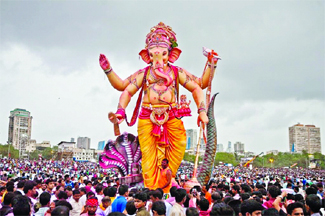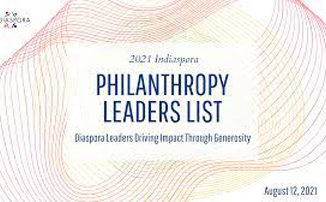
The festival of Ganesh Chaturthi is celebrated to honor the Hindu god Ganesh. The festival, also known as Vinayaka Chaturthi is observed in the Hindu calendar month of Bhaadrapada, starting on the shukla chaturthi (fourth day of the waxing moon period) and lasts for 10 days, ending on Anant Chaturdashi (fourteenth day of the waxing moon period). People start celebrations by preparing months in advance by making eco-friendly idols, artistic clay models of Lord Ganesha and decorating the idols. The size of these idols vary from inches to feet. Ganesh Chaturthi starts with the installation of these Ganesh statues in colorfully decorated homes and specially erected temporary structures mandapas (pandals) in many localites. The pandals are decorated using decorative items like flower garlands, lights, etc.. Some pandals are made theme based which depict religious themes, events related to Lord Ganesha or sometimes current events. The collective celebrations of Ganesha Chaturthi dates back to early 1890. At that time the society was divided on the basis of caste and relegious beliefs. LokManya Bal GangaDhar Tilak decided to bring the divided society into one thread and asked the people to come together and celebrate the festival in collective manners.
During the celebrations, the chanting of mantras invokes the presence of Ganesha. This ritual is the Pranapratishhtha. After this, the ritual called as Shhodashopachara (16 ways of paying tribute) follows during which Coconut, jaggery, modaks, durva blades of grass and red flowers are offered. The statue of Lord Ganesha is anointed with red unguent, made of kumkum and sandalwood paste. The festival ends with Ganesha visarjana during which these installed statues of Lord ganesha are immersed into the water bodies sea and river.
The Legend of Lord Ganesha
To understand the essence of Ganesh Chaturthi, it’s important to know the legend behind Lord Ganesha’s birth. According to Hindu mythology, Lord Ganesha is the son of Lord Shiva, the destroyer, and Goddess Parvati. The story goes that Parvati created Ganesha from the clay of her body and breathed life into him, thus making him her son and a guardian of her privacy.
One day, when Parvati was taking a bath, she asked Ganesha to stand guard outside her chamber. When Lord Shiva returned home and attempted to enter, Ganesha, unaware of his divine lineage, stopped him as per his mother’s instructions. This led to a fierce battle between the two, resulting in Lord Shiva beheading Ganesha.
Upon realizing the mistake, Lord Shiva and Parvati were grief-stricken. To make amends, Lord Shiva promised to bring Ganesha back to life by replacing his head with that of the first living being he encountered. This happened to be an elephant, thus giving Ganesha his iconic elephant-headed form. Lord Shiva also declared Ganesha as the “Lord of Beginnings” and “Remover of Obstacles,” making him a revered deity in Hinduism.
The Significance of Ganesh Chaturthi
Ganesh Chaturthi, which falls on the fourth day of the bright half of the Hindu lunar month of Bhadrapada (usually in August or September), is celebrated to commemorate the birth of Lord Ganesha. This festival holds immense significance for several reasons:
Remover of Obstacles
Lord Ganesha is worshipped as the deity who removes obstacles and grants success and prosperity. People seek his blessings before starting new ventures, weddings, or any significant life event.
Symbol of Wisdom
Ganesha is also revered as the God of wisdom and intellect. Devotees pray to him for guidance and knowledge, especially students seeking success in their studies.
Unity and Harmony
Ganesh Chaturthi transcends caste, creed, and social boundaries. It brings people from diverse backgrounds together in celebration, fostering unity and communal harmony.
Cultural Celebration
Beyond its religious significance, Ganesh Chaturthi is a cultural extravaganza, featuring music, dance, processions, and elaborate decorations.
Ganesh Chaturthi Celebrations
Ganesh Chaturthi celebrations typically span ten days, with the most elaborate festivities occurring on the first and last days. The festival begins with the installation of clay idols of Lord Ganesha in homes and public places. These idols are beautifully decorated with flowers, jewelry, and colorful clothing.
Devotees offer prayers, perform aarti (rituals involving the waving of lamps), and sing bhajans (devotional songs) to seek Lord Ganesha’s blessings. Modak, a sweet dumpling, is a favorite offering to the deity, symbolizing the sweet rewards of life. On the final day of the festival, the idols are immersed in water bodies, symbolizing the departure of Lord Ganesha back to his abode while cleansing the surroundings of negativity.
Ganesh Chaturthi is not merely a religious festival; it’s a celebration of faith, culture, and unity. It reminds us of the importance of seeking wisdom and guidance, overcoming obstacles, and fostering communal harmony. As the vibrant celebrations unfold each year, Ganesh Chaturthi continues to be a source of joy, hope, and renewal for millions of people, making it one of India’s most cherished festivals.
Important events
– Prana Pratishtha: This ceremony installs the Ganesha idol in the home or temple. It is performed on the Chaturthi Tithi.
– Aarti: This prayer ritual is performed on Lord Ganesha daily during the festival.
– Hawan: This is a fire ritual that is performed to invoke the blessings of Lord Ganesha. It is usually performed on the first and last day of the festival.
– Visarjan is the ceremony of immersing the Ganesha idol in a river or ocean. It is performed on the Dashami Tithi.




Be the first to comment